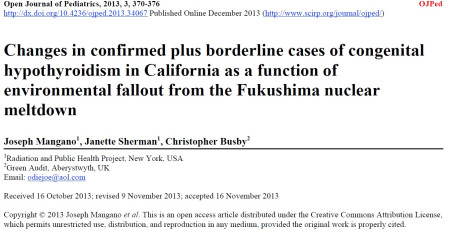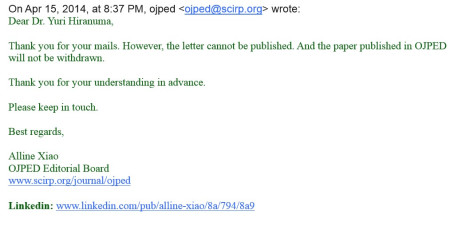
This article, “Changes in confirmed plus borderline cases of congenital hypothyroidism in California as a function of environmental fallout from the Fukushima nuclear meltdown” was published in the Open Journal of Pediatrics, a journal published by Scientific Research Publishing (SCIRP), a publisher included on my list of questionable publishers.
The article reports that fallout from the Fukushima nuclear accident increased the number of confirmed congenital hypothyroidism cases in the population studied.
The article’s findings were reported in the media, including a report on ABC 10 in San Diego and Yahoo! News, among others.
However, some independent researchers are questioning the study’s validity. According to Dr. Yuri Hiranuma:
“The actual count of confirmed cases of congenital hypothyroidism (CH) from the California Public Health Department does not match the authors’ count because they disregarded the actual count given to them. Instead, the authors (1) invented their own definition of confirmed cases of CH, (2) misrepresented the real definition of CH, and (3) invented a fictitious diagnostic category of CH which they call “borderline cases. Unfortunately, the study is widely disseminated as the “proof” of the effect of Fukushima fallout on the west coast.”
Dr. Hiranuma wrote up her objections to the study and submitted them as a letter to the journal. However, the journal refused to publish her letter. The letter has since been published on this blog. They sent her this response:

Next, Dr. Hiranuma sent an email asking why the letter would not be published, and she got this reply:

I think one reason they won’t publish the letter is they only want to publish revenue articles — they don’t want to publish a letter for free. The following email confirms this:

Analysis: This is a case of several researchers who are concerned about health effects of radiation exposure using a predatory journal to publish questionable science that bolsters their position on the adverse health effects of low level radiation exposure. Upon publication of the article, they were successful in getting some media outlets to report their findings, and the findings were seen as legitimate because they were published in a scholarly journal. The journal’s publisher remains faithful to its customers (the paper’s authors, who paid to have their article published) and refuses to retract the article or publish a standard response to it. The academic record remains uncorrected.
I recommend viewing the following video, which provides a pitch-perfect explanation of the situation:
By: Jeffrey Beall
Follow on Twitter
Source: Scholarly Open Access
Comments:
Susan Ariew says:
April 29, 2014 at 9:16 AM
Amazing. This story should go to those news outlets who published the results of the study initially, though I wonder, too, if they will care.
Bill Williams says:
April 29, 2014 at 12:55 PM
This is certainly a scary example of the dangers of predatory publishing.
Bill Williams says:
April 29, 2014 at 3:49 PM
Yes, this is a scary example of the dangers of predatory journals.
bill says:
April 30, 2014 at 3:07 AM
Duplicate posts: I have wondered why we have seen various near-duplicate posts here. Now it’s happened to me, I see why – its an occasional hiccough with Wordpad: sometimes the platform doesn’t appear to have received our post (as happened to me yesterday) so after some time with nothing appearing, one tries a second time to post the same contribution. Then some time later both appear.
Jeff Shrager says:
April 29, 2014 at 9:55 AM
So, youtube is now a scholarly publisher? I guess at least it’s open access and doesn’t charge for publication. I’m guessing that it’s peer review process leaves something to be desired.
Why don’t they just publish the rebuttal in another journal?
roryrobertsonformerfattie says:
April 29, 2014 at 1:56 PM
MDPI’s Nutrients journal wouldn’t publish my letter either, but underperforming Editor-in-Chief Professor Peter Howe in Australia was happy to publish an “Editorial” slamming me for pointing out that his journal’s quality control was incompetent if not non-existent: http://www.mdpi.com/2072-6643/4/4/258
In part because of this nonsense, Jeffrey Beale has added MDPI to his widely appreciated List of Questionable Publishers: https://scholarlyoa.com/2014/02/18/chinese-publishner-mdpi-added-to-list-of-questionable-publishers/
It will be interesting to see what comes from the University of Sydney’s formal research-misconduct inquiry into its low-GI advocates’ extraordinarily faulty – and self-published – Australian Paradox research: http://www.australianparadox.com/pdf/LettersProfTrewhella.pdf
Here’s Australian national radio’s February 2014 investigation of the matter: http://www.abc.net.au/radionational/programs/backgroundbriefing/2014-02-09/5239418
And here’s my submission to the University of Sydney’s formal research-misconduct inquiry: http://www.australianparadox.com/pdf/RRsubmission2inquiry.pdf
Marco says:
April 30, 2014 at 8:36 AM
Mangano & Sherman have form, and it is not just OA Publishers they use. Take this paper:
http://www.radiation.org/reading/pubs/HS42_1F.pdf
Which is published by Baywood. Its analysis has been heavily criticized for similar reasons as this current paper.
Alex SL says:
April 30, 2014 at 4:17 PM
Wow, that is an interesting aspect of not only predatory but open access publishing in general that I had completely overlooked so far. If you run your journal by collecting fees for publication, publishing rebuttals, corrections or letters for free is rather… inconsistent. Where does one draw the line? One could even say that accepting such a letter for free sets a bad precedent in that economic model. And of course retracting something would have to involve reimbursing the publication fee…
The incentives for publishers in an open access system are really problematic. If only we had the political will to create a non-profit publishing system with decent quality control and the right incentives in place instead of trying to “solve” the profiteering problem by shifting the profiteering from reading fees to publishing fees!
Frederick Guy says:
May 8, 2014 at 3:22 AM
This would be a nice point if it were true that subscription-funded publishers did routinely publish letters. Some will publish responses which are essentially mini-papers – others will not even do that, and very, very few will publish letters which, e.g., call out simple logical fallacies or sloppy work. I think it’s mostly because editors would rather not have their own bad judgements publicized. That, in any case, is how it stands in economics and some other social science fields with which I am familiar – unless it’s so different in your field, don’t blame open access.
Susan Ariew says:
June 18, 2014 at 7:27 AM
I warned one of my faculty off of publishing with SCIRP this morning. This blog post helped to explain why journals from SCIRP are not considered reputable OA journals.
Jeffrey Beall says:
June 18, 2014 at 7:28 AM
Thanks, Susan!
Roger says:
October 28, 2014 at 3:37 AM
anti-nuclear activists thrive on these predatory journals. The three authors of this article all have been long known to be phony scientists. All are colleagues of Leuren K Moret who has filled YouTube, as has Christopher Charles Busby with false claims about Fukushima. Moret really is on the edge, she claims that the earthquake that triggered the tsunami was caused by US tectonic warfare using the High Frequency Active Auroral Research Program (HAARP) facility at the University of Alaska. Author Busby shares the stage in one video with Moret. Janette Sherman claims that she measured high radiation near the Pentagon on 9/11, proof that the attack was actually by a depleted uranium tipped missile. She also edited NY Academy of Sciences controversial book by Russian pseudoscientists about Chernobyl that claim millions of resultant cancers. Busby claims uranium and depleted uranium are incredibly diabolic and claims to have done epidemiology studies to prove that along with another colleague Mozghan Savabiesafahani who falsely claimed to be a post-doctoral researcher at the University of Michigan doing work for the World Health Organization. These liars and the journals that they choose to post their lies need to be fully exposed and the news media convinced that they are lying for their supper.
Martha McCaughey says:
July 19, 2016 at 11:50 AM
The scary thing is the journalists often simply Google to find experts on the topic they are covering, and these online OA journals pop up in those searches. Journalists as well as current college students and instructors need to know how to tell the difference between questionable, predatory academic journals and real, credible ones.





